Step into the charm of a farmhouse kitchen, where rustic warmth meets modern functionality. Farmhouse kitchens have become a favorite for those who appreciate a timeless aesthetic, balancing old-world charm with updated conveniences.
From weathered wood finishes and shiplap walls to vintage-inspired fixtures and open shelving, each element adds character, making your kitchen the heart of the home. Imagine cozy family dinners around a reclaimed wood table or mornings spent with a fresh coffee aroma filling the room, surrounded by earthy textures and inviting tones.
Create your ideal farmhouse kitchen with clever storage solutions, classic farmhouse sinks, and thoughtful design tips that bring authenticity to the space.
For those drawn to a cozy, welcoming vibe, farmhouse kitchens offer endless inspiration, allowing you to make the most of every corner. Ready to start your journey toward the farmhouse kitchen of your dreams? Explore our handpicked ideas and see how simple additions can turn your kitchen into a rustic haven.
1. Embrace Open Shelving
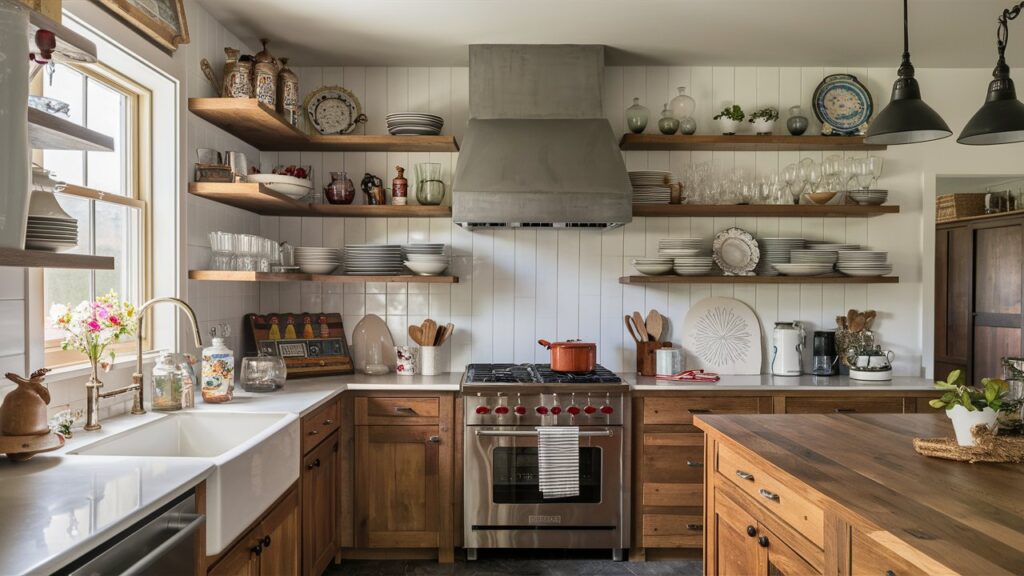
Open shelving is a hallmark of farmhouse kitchens, offering a casual, welcoming vibe. By removing upper cabinets and replacing them with open shelves, you can display your favorite dishes, glassware, and decorative items.
This not only makes the space feel larger but also encourages a more personal touch. Consider using reclaimed wood for the shelves to enhance the rustic aesthetic. You can mix and match different styles of dishes—think vintage china paired with modern glassware—to create an eclectic look.
Additionally, open shelving encourages easy access to everyday items, making cooking and entertaining more convenient. To maintain organization, use baskets or decorative boxes on the shelves to store smaller items or pantry staples.
2. Incorporate a Farmhouse Sink
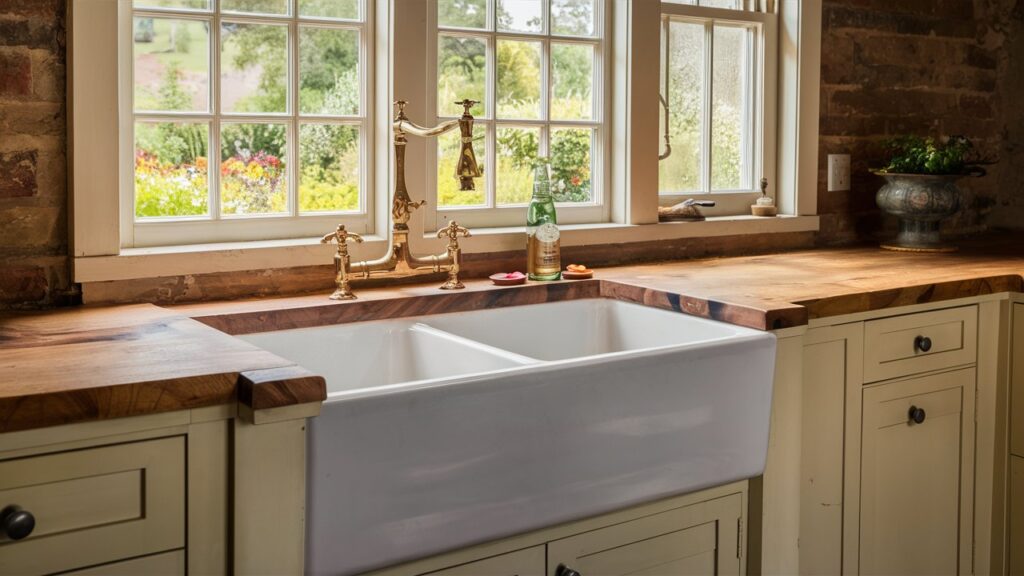
A farmhouse sink, also known as an apron-front sink, is a defining feature of this style. Its deep basin is perfect for washing large pots and pans, making it both functional and stylish.
When selecting a farmhouse sink, you can choose from materials like porcelain or stainless steel, depending on your kitchen’s overall aesthetic. Pair your sink with a vintage-style faucet to complete the look.
Surrounding the sink with butcher block countertops can enhance the rustic feel while providing a durable workspace for meal prep. Additionally, consider adding a window above the sink to bring in natural light and offer a view of your outdoor space.
3. Use Vintage-Inspired Appliances

To achieve an authentic farmhouse vibe, opt for vintage-inspired appliances that combine retro aesthetics with modern efficiency. Brands like Smeg and Big Chill offer refrigerators and ranges in pastel colors or classic white that evoke nostalgia while providing contemporary functionality.
These appliances can serve as focal points in your kitchen, drawing attention and sparking conversation. For instance, a bright red retro fridge against white cabinetry can create a stunning contrast while maintaining the cozy feel of a farmhouse kitchen.
Additionally, consider incorporating vintage accessories like an old-fashioned mixer or classic cookware displayed on open shelves.
4. Add Rustic Wood Accents

Wood is central to farmhouse design, so incorporating rustic wood accents can enhance the warmth of your kitchen. Consider exposed wooden beams on the ceiling or reclaimed wood paneling on walls to add character and texture to the space.
A large wooden dining table can serve as both a functional eating area and a gathering spot for family and friends. Choose pieces that showcase natural imperfections—knots, grains, and variations in color—to emphasize authenticity.
You might also consider wooden stools at the kitchen island or butcher block countertops that add warmth while being practical for food preparation.
5. Create a Cozy Breakfast Nook

A breakfast nook is an excellent way to maximize space while creating an inviting area for casual meals. You can transform an unused corner of your kitchen into a cozy nook by adding built-in benches with plush cushions and a small table.
To enhance the farmhouse feel, use vintage fabrics for cushions and add decorative pillows in soft patterns like florals or checks. Surrounding your nook with windows will allow natural light to flood in, making it an inviting spot for morning coffee or family breakfasts. Consider hanging pendant lights above the table to create an intimate atmosphere during evening meals.
6. Incorporate Shiplap Walls
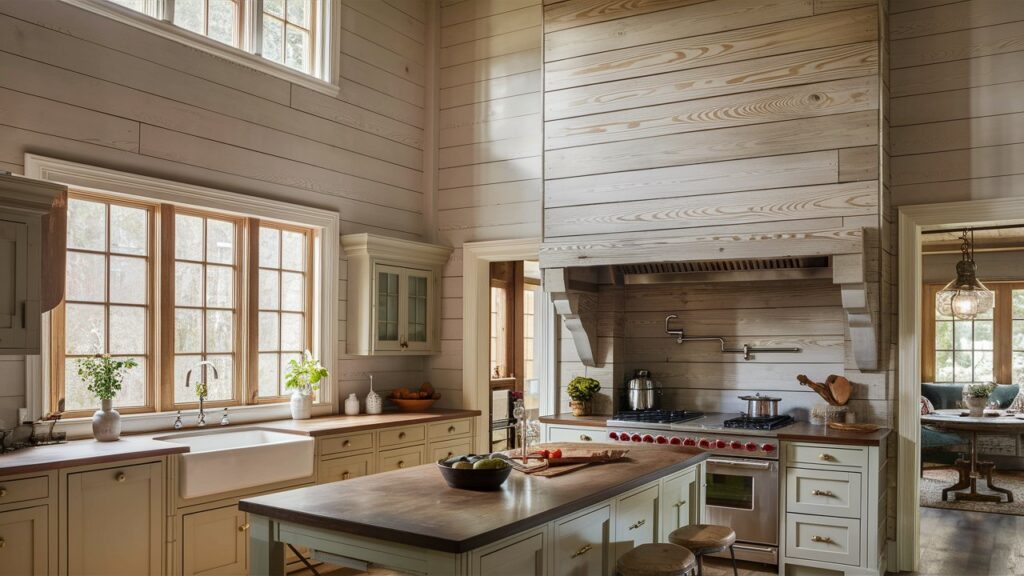
Shiplap is synonymous with farmhouse design and adds texture and depth to any kitchen space. This wooden paneling can be used on walls or even as a backsplash behind your stove or sink for added interest.
Painting shiplap in soft whites or muted pastels can brighten up the room while maintaining that rustic charm. If you prefer a more dramatic look, consider leaving the wood in its natural state or staining it to highlight its grain patterns. Shiplap not only enhances visual appeal but also creates a cozy atmosphere reminiscent of traditional farmhouses.
7. Utilize Vintage Decor
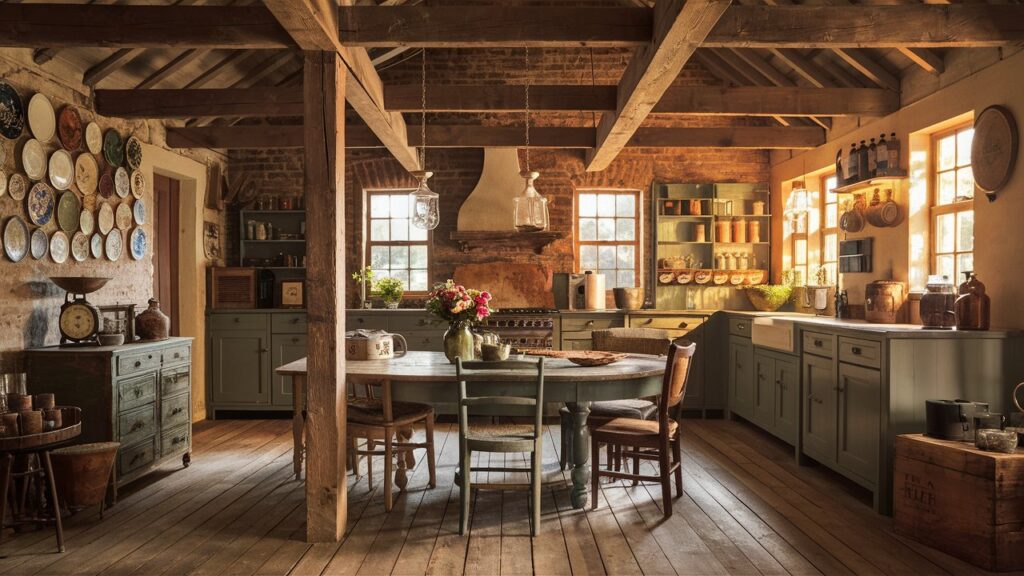
Incorporating vintage decor elements is key to achieving that authentic farmhouse feel in your kitchen. Look for antique items at flea markets or thrift stores—think old scales, wooden crates, or vintage jars—that you can use as decorative accents or functional storage solutions.
Display these items on open shelves or countertops to create visual interest without cluttering the space. A collection of mismatched plates hung on the wall can also serve as art while showcasing your personality and style. Remember that each piece tells a story; thus, mixing various eras will give your kitchen character.
8. Choose Neutral Color Palettes

Choosing a neutral color palette is a key element in farmhouse kitchen design, evoking a sense of calmness, simplicity, and timeless appeal. Soft whites, warm creams, gentle grays, and muted earth tones blend beautifully to create an inviting, cohesive look that doesn’t overwhelm the senses.
These shades provide a clean and airy feel, making the kitchen appear open and uncluttered while adding subtle elegance.
You can apply these neutrals to walls, cabinets, countertops, and even appliances, creating a harmonious flow throughout the space. For added warmth, consider integrating natural wood tones through elements like cabinetry, shelving, furniture, or flooring. Wood textures, with their organic warmth, perfectly complement neutral colors, adding character and a rustic charm without competing for attention. The blend of neutrals and wood not only enhances the farmhouse aesthetic but also ensures the kitchen remains timeless, cozy, and welcoming.
9. Install Pendant Lighting
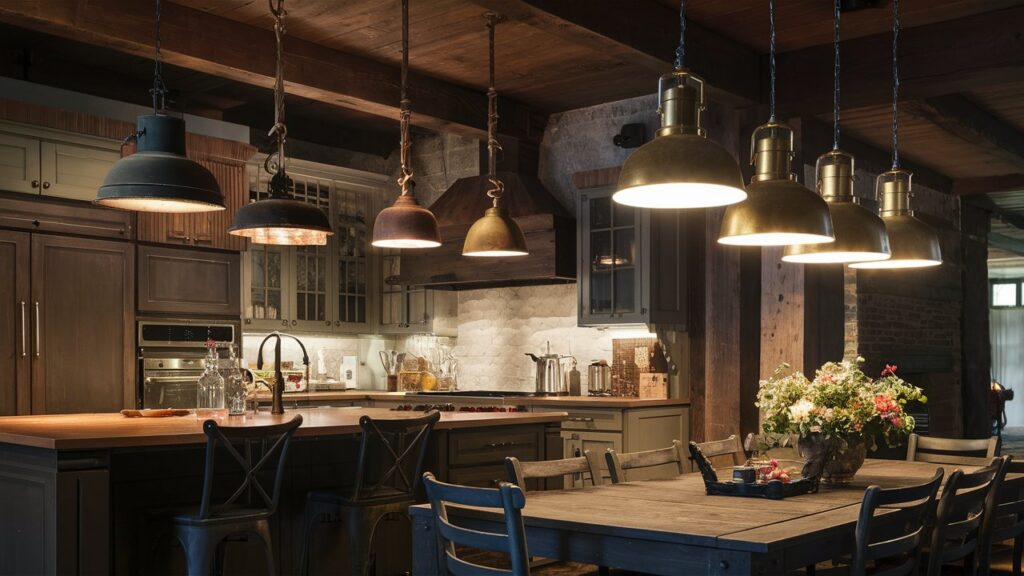
Installing pendant lighting is an excellent way to create a warm and inviting atmosphere in a farmhouse kitchen. Pendant lights add both style and practical illumination, making them perfect for spaces where function and ambiance are equally important.
Look for fixtures crafted from materials like wrought iron, aged brass, or weathered wood to complement the rustic charm of a farmhouse kitchen. These materials not only provide ample lighting but also bring texture and character to the space, enhancing its overall design.
Consider placing pendant lights above work areas, such as kitchen islands or dining tables, where targeted lighting is most useful. Mixing different pendant styles—such as industrial fixtures with more classic, vintage-inspired designs—can introduce visual interest and personality without disrupting the cohesive farmhouse aesthetic.
Additionally, adjustable height features can help tailor the lighting to specific needs, creating a functional, stylish, and inviting kitchen that reflects the rustic elegance of farmhouse design..
10. Create Functional Workspaces
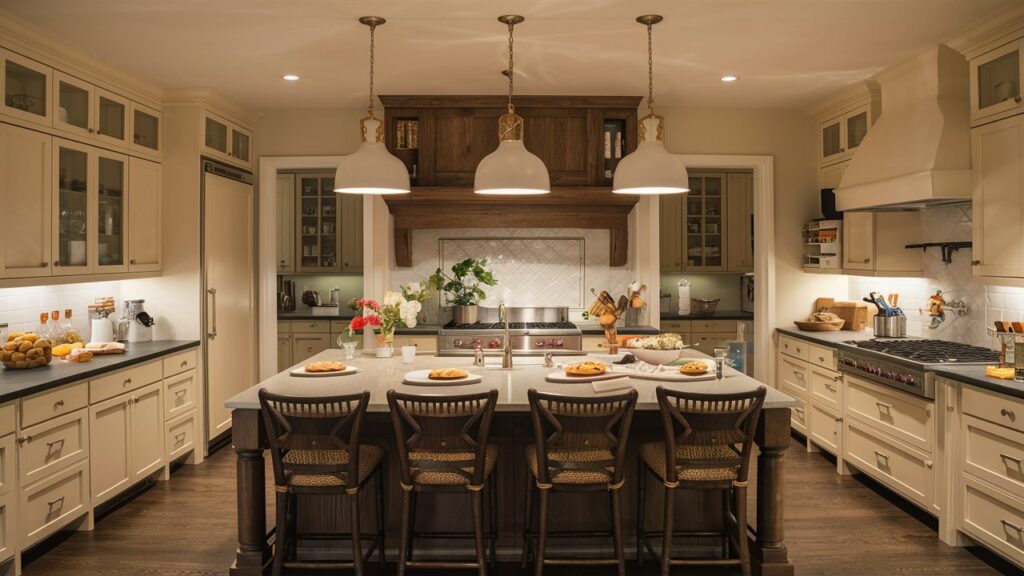
Creating functional workspaces is essential for a well-designed farmhouse kitchen that seamlessly blends charm with efficiency. When setting up the kitchen, aim to create distinct zones for specific tasks to make meal preparation and cooking sessions a breeze.
An island with ample counter space is a fantastic addition; it can serve as a gathering spot where family members or guests can interact with the cook, bringing a social element to the kitchen. For bakers, consider dedicating a space near essential ingredients like flour and sugar with drawers for measuring tools, creating a convenient baking zone.
Similarly, for chopping and prepping, set up a station close to the sink with cutting boards and knives readily accessible to make cleanup easier. Additionally, make sure appliances like mixers or blenders are close to electrical outlets in each zone, further enhancing efficiency. Thoughtful layout choices create a farmhouse kitchen that’s both functional and inviting for the entire family.
11. Use Textiles Wisely
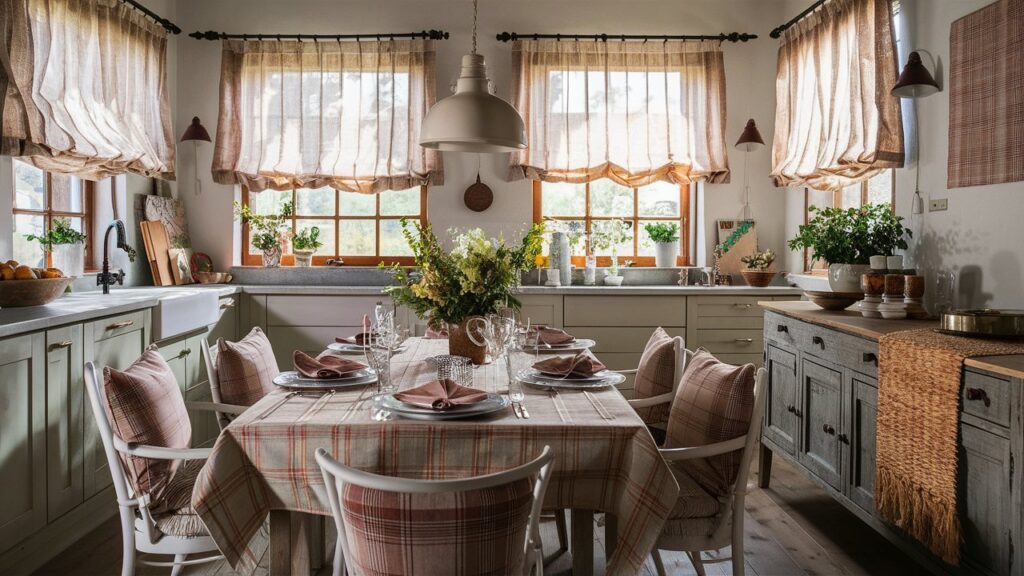
Using textiles thoughtfully can bring a welcoming warmth and sense of comfort to a farmhouse kitchen. By incorporating various fabrics, such as curtains, table linens, and towels, you can introduce softness and enhance the rustic charm of the space.
Opt for natural materials like cotton and linen, which are not only durable but also evoke simplicity and authenticity, staying true to the farmhouse aesthetic. For added depth, consider layering different patterns—such as subtle stripes, checks, or plaids—to create visual interest without overwhelming the eye.
Pairing a solid-color tablecloth with patterned napkins, for example, can strike a lovely balance that feels inviting but not overly busy. Pay attention to how colors and textures complement each other, as balance is essential to achieving a harmonious look. Thoughtfully chosen textiles can make a farmhouse kitchen feel cozy and lived-in, adding just the right touch of style and warmth to your space.
12. Incorporate Modern Elements

Incorporating modern elements into a traditional farmhouse kitchen can create a beautiful blend of old and new, adding depth and character to your space. Start by pairing sleek stainless-steel appliances with rustic, weathered cabinetry to establish a striking contrast that feels both current and cozy.
Minimalist hardware, such as matte black or brushed brass knobs and handles, adds a functional yet understated touch, ensuring these accents complement rather than compete with other design elements.
Consider adding open shelving in dark metal or reclaimed wood to bring an industrial edge that still aligns with farmhouse charm. For lighting, pendant fixtures with clean lines or exposed bulbs can introduce a modern vibe, while maintaining the warm, inviting feel.
Integrating subtle pops of color through accessories like bar stools, dishware, or art can also refresh the traditional look. This thoughtful balance of rustic and modern elements will result in a farmhouse kitchen that feels both timeless and updated.
13. Create Zones with Rugs
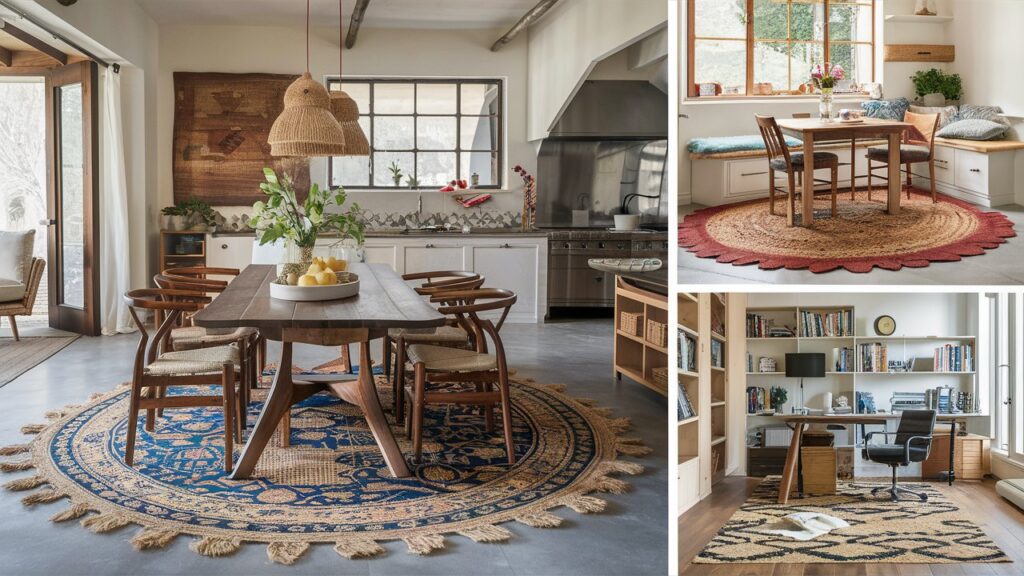
Rugs are an effective way to create distinct zones in open-concept layouts, helping to define spaces like dining areas, breakfast nooks, and workstations within a larger room. By placing an area rug beneath furniture, you add comfort and visually set boundaries, giving each section its own identity.
This is especially useful in spaces without walls, where rugs can help subtly guide the flow of movement. Choosing durable materials like jute, wool, or synthetic blends ensures your rugs withstand high foot traffic while maintaining a stylish appearance.
For example, a jute rug under a dining table can add a natural, earthy texture, enhancing a casual aesthetic, while a patterned wool rug beneath a desk can add warmth and color to a workspace. Select colors and patterns that harmonize with your decor, and consider contrasting rug shapes and sizes to further highlight the purpose of each area.
14. Personalize Your Space
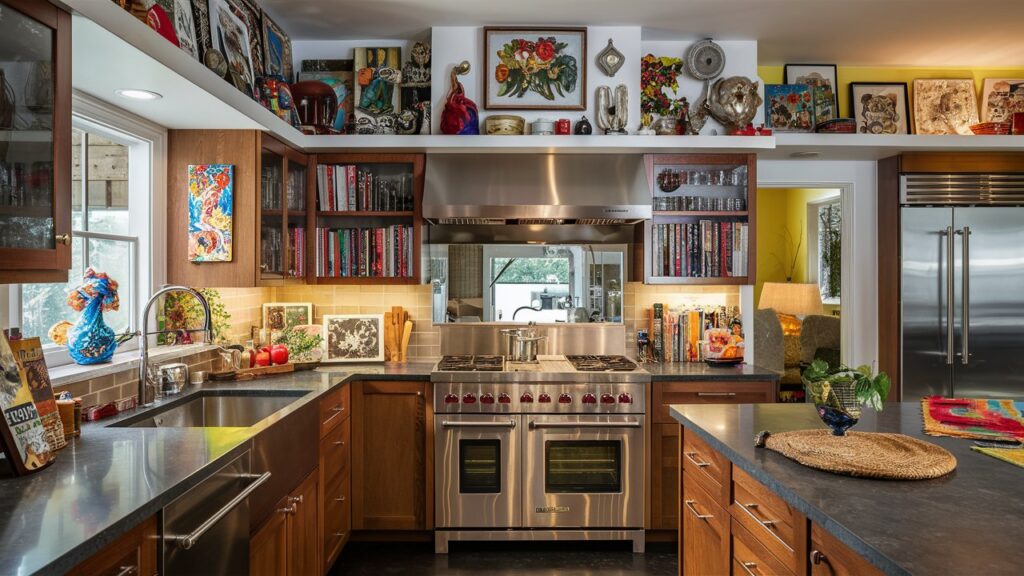
Personalizing your kitchen can transform it from a functional space into a warm and inviting area that truly reflects who you are. Incorporating family heirlooms, such as a vintage dish passed down through generations or a cherished set of silverware, adds depth and history.
Displaying personal artwork or pieces from your favorite local artists can bring color, texture, and a sense of inspiration to the walls. Showcase your favorite cookbooks on open shelves or counters, making them easily accessible and adding a personal touch that reflects your culinary tastes.
Unique pottery, treasured collectibles, or framed family recipes can be positioned thoughtfully to tell your story. These meaningful items not only enhance the aesthetic appeal but also make the kitchen feel like an extension of you, reminding you of loved ones and personal memories as you cook, dine, and share moments with family and friends.
2.Benefits of Farmhouse Kitchen Ideas
- Warm and Inviting Atmosphere: Farmhouse kitchens create a cozy environment that feels welcoming and homely, often considered the heart of the home.
- Timeless Design: This style blends rustic charm with modern convenience, making it appealing across generations and suitable for various home types.
- Natural Light Enhancement: Open concept layouts typical in farmhouse kitchens allow for increased natural light, creating a bright and airy space.
- Functional Layout: The design promotes efficiency, with thoughtful zoning for cooking, prepping, and entertaining, making meal preparation easier and more enjoyable.
- Versatile Storage Options: Features like open shelving and kitchen islands provide ample storage while also serving as display areas for decorative items.
- Durable Materials: Farmhouse kitchens often utilize high-quality natural materials that are long-lasting and require less maintenance compared to more modern designs.
- Community Focus: The layout encourages family gatherings and social interactions, making it ideal for entertaining guests or spending time with loved ones.
- Simplicity in Design: The aesthetic emphasizes a ‘less is more’ approach, creating a clutter-free environment that is easy to maintain and visually appealing.
- Adaptability: Farmhouse kitchen designs can be customized to fit various styles, from minimalistic to more eclectic looks, allowing homeowners to express their personal taste.
- Connection to Nature: Incorporating elements like farmhouse gardens or natural decor fosters a connection to the outdoors, enhancing the overall ambiance of the kitchen
Conclusion
Farmhouse kitchens bring a cozy, welcoming charm that blends traditional appeal with modern functionality. These spaces often feature warm, rustic elements like exposed wood beams, vintage-style fixtures, and a mix of natural materials, creating an inviting atmosphere perfect for gathering.
Adding touches like open shelving, apron-front sinks, and neutral color palettes helps capture the essence of farmhouse style while allowing flexibility for personal flair.
Whether incorporating antique accents or industrial touches, farmhouse kitchens offer a versatile design that adapts to different lifestyles. In essence, a farmhouse kitchen is more than a style; it’s a warm and functional space that makes everyone feel at home.

